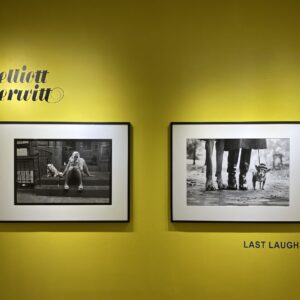JTF (just the facts): A paired exhibit of works made by Letha Wilson and Gamaliel Rodríguez, hung against white walls (and displayed on white pedestals) in two connected gallery spaces on the main floor and two spaces on the second floor.
The following works by Letha Wilson have been included in the show (installation and detail shots below):
- 1 archival inkjet prints, 2018, sized roughly 23x19x3 inches
- 3 unique c-print, concrete, UV print, aluminum frame, 2020, sized roughly 18x14x1, 24x32x1, 34x28x2 inches
- 1 UV prints and reclaimed steel, 2020, sized roughly 22x18x18 inches
- 2 UV prints on steel, 2021, sized roughly 23x27x10, 28x15x19 inches
- 2 UV prints on steel, paint, steel frame, 2023, sized roughly 19x14x2, 30x24x4 inches
The show also includes 5 works (acrylic, ink, and gold leaf on paper/canvas or ballpoint, acrylic, and colored pencil on paper) by Gamaliel Rodríguez.
Comments/Context: The pandemic upended the artistic timelines of many if not most contemporary photographers. Work schedules and processes were disrupted, exhibition calendars were delayed or reorganized, materials became scarce, and the consistent isolation altered mindsets and priorities. So when Letha Wilson showed a selection of smaller folded (and ingeniously re-foldable) works in 2023 (reviewed here), we got a taste of what she had been working on during those years of tumult, but in many ways, that discrete body of work didn’t really tell the whole story of her progression since her last New York gallery show in 2018 (reviewed here). Happily, this paired show with Gamaliel Rodríguez provides many of the missing links, in a tightly edited survey of her output in the past five years.
Wilson has been thoughtfully exploring the intersection of photography and industrial materials for nearly two decades now, iteratively experimenting with different ways to rethink landscapes, sunsets, and natural scenes via physical interventions that introduce machined surfaces, cutouts, folds, fans, rolls, and other sculptural forms. Each work along her artistic journey has been an exercise in mixing the natural with the man made, bringing intimate sculptural physicality to the innate grandeur of the natural world.
The earliest work from Wilson on view in this show (from 2018) begins with up close images of textural evergreen branches. The pictures capture the individual branches as they separate into thin needles (and a few stems) that then draw us into a dense all-over thicket of striated green. From there, Wilson has folded the prints in a narrow back-and-forth fan shape, and interrupted the central area with two linear slots that angle off to one side, created hard-edged geometries that seem to echo and reconsider nature’s own organizational arrangements.
By 2020, presumably during the outbreak, Wilson moved on to modestly sized wall-based works that intermingle paper photographs, concrete, and overprinting in actively mashed together combinations. Some of Wilson’s earlier efforts involving concrete had edged toward the monumental in scale and heft, but as seen here, she has returned to more manageable proportions that encourage up close examination. Her source images provide a range of natural settings and combinations: tropical greenery in Hawaii with nasturtiums in Nevada; Hudson Valley deciduous trees with Washington State evergreens; and Death Valley rock formations with Hawaiian lava flows. Wilson uses these images in pairs, one on physical paper and one UV printed over the top like strips of tape (and even running over the edge of the frames). Underneath, the visual juxtapositions and contrasts of the photographs are roughly interrupted by areas of flattened concrete that push, crumple, and jostle the photographic patterns, like stacked layers of sedimentary rock. Each composition becomes a fight between three separate visual ideas, ultimately settling down into a kind of uneasy (but often lyrically elegant) coexistence.
Later that year, and onto 2021, that set of ideas seems to have run its course, with Wilson moving on to more three dimensional works again. The common thread that ties these works together is images mounted to arced steel, the planes of which are then intersected or folded back, in some cases with a second complementary photograph on the other side. One work plays with arcs of Death Valley rock matched with a ring of rusty reclaimed steel, while another pairs an image of a Yellowstone sunrise with another of textural lava flows from Idaho, the geometries alternately straight and curved, with the raw steel backing exposed here and there as its own compositional element. Having jumped off the wall and onto pedestals in the middle of the gallery, these works function much more as three dimensional objects, with alternate juxtapositions and spatial dynamics becoming evident from different viewing angles; these works also seem to provide a conceptual bridge to the folded works Wilson would go on to show later in 2023.
The most recent works on view in this show (also from 2023) find Wilson doing more with steel frameworks and the possibilities of open space within a rectangular border. The photographs travel in familiar subjects: granite rock formations and sunsets, both taken at Joshua Tree National Park in California. In both cases, Wilson has created a doubled layout with two overlapped photographs of the same scene, each mounted to steel and welded into the frame with exposed rivets (that also tend to blister the edges of the photographs in pleasing ways). In one work, she has folded the prints, creating triangles of exposed white back sides; in the other, the images have been cut with curves and semicircles and folded along the supporting braces of steel. Both results have intriguing complexities of space, but are hung on the wall, pushing outward and creating see through areas to the gallery wall behind.
Seen together, these various aesthetic evolutions feel managed and precise, with Wilson largely innovating within her own set of self-imposed boundaries. As a result, there are no spectacular jumps or particular unexpected surprises here, but more a range of previously successful ideas that she continues unpack, rebuild, and refine over time. If anything, Wilson seems to becoming more comfortable with wrangling steel, and more interested in how that steel can interact with photographic imagery in sculptural ways. Given the initial examples here, this seems like a fruitful avenue for further exploration, where Wilson coaxes metal frameworks and armatures to present photographs in unique ways.
Collector’s POV: The works in this show are priced between $6500 and $14000. Wilson’s work has little secondary market history at this point, so gallery retail likely remains the best option for those collectors interested in following up.
























